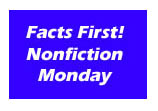 We’re continuing our study of African animals, and lions are our focus today. Both of my daughters were fascinated by the stunning photos and cool facts in Face to Face with Lions by Beveryly and Dereck Joubert. The authors have spent 25 years studying the lions of Africa and living among them, and their passion for these amazing creatures shines through in their book. Readers learn about the impact of habitat loss and hunting on lion populations and receive information about what we can do to make the world a better place for lions and other top predators. I highly recommend this book for anyone interested in big cats, predators, animals conservation, or animal life in Africa.
We’re continuing our study of African animals, and lions are our focus today. Both of my daughters were fascinated by the stunning photos and cool facts in Face to Face with Lions by Beveryly and Dereck Joubert. The authors have spent 25 years studying the lions of Africa and living among them, and their passion for these amazing creatures shines through in their book. Readers learn about the impact of habitat loss and hunting on lion populations and receive information about what we can do to make the world a better place for lions and other top predators. I highly recommend this book for anyone interested in big cats, predators, animals conservation, or animal life in Africa.
This week’s Non-Fiction Monday Round-up is at Capstone Connect.
















